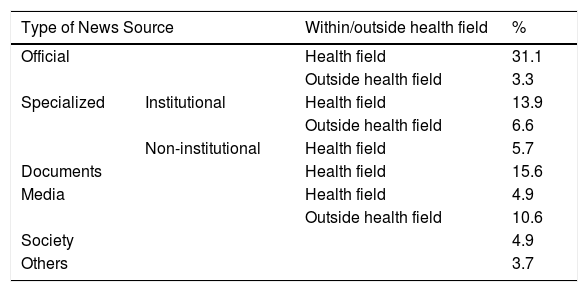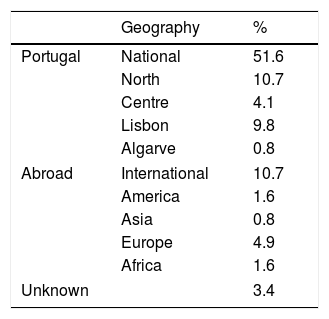From a public health perspective, media can influence public perceptions towards the severity of an illness, the risks of becoming ill, change seek-care behaviours or reduce disease related stigma.
Material and methodsWith the aim analysing the media coverage of tuberculosis in the Portuguese press, we analyzed all news texts published between 2012 and 2014 in six National newspapers (Expresso, Público and Diário de Notícias – broadsheets; Sol, Jornal de Notícias and Correio da Manhã – tabloids). Our corpus was composed of 10,736 news pieces and 23,495 news sources. We then conducted a quantitative analysis based on descriptive statistics, through the data analysis software SPSS.
ResultsTumours, HIV-Aids, Influenza, Transplants, Hepatitis, Obesity, Dengue, Mental Disorders and Heart Diseases were the most media covered pathologies, ahead of tuberculosis. Tumours represented 22% of all news, tuberculosis only represented 1.9% – there is a noteworthy difference among media treatment.
When it comes to the news themes, Tuberculosis was mainly news due to alarm and risk situations (53.4% of all texts). This also means that stories were usually negative, which may lead to a stigmatization of this disease. Even though the numbers were not very expressive, there was some media attention thrown at prevention.
ConclusionMedia intervention is a fundamental public health tool that could be more developed – it would be important to understand what are the interventions with higher impact on health and how to better use them.
Health communication is recognized by several authors as a fundamental public health tool.1,2 Therefore, health communication has become an established field within public health2 and there is a broad awareness on the scope of health communication and its strategic areas. This is especially true in the United States, where health communication has been studied for the past few years. However, the Portuguese panorama is considerably different and we would argue that the importance of such discipline is yet to be recognized. This same reality is stated by Annegret F. Hannawa and her colleagues,3 who say that “to date, health communication research has mainly been represented by a United States-dominant perspective”, even though it is “a topic of international interest”.
Despite this, it is true that both health and medicine are a prominent element in the contemporary news agenda. Indeed, media can be perceived as a public health policy tool.4 And even though reporters are usually not up to the idea of media being used to prevent cancer, for instance, health journalism does promote different attitudes among journalists.4 Although media can contribute to public health, it is worth keeping in mind that both disciplines have different goals. And this may constitute a problem, both for health educators using media to reach the public and for journalists covering health issues.5
From a public health perspective, media can influence public perceptions towards the severity of an illness, the risks of becoming ill, and so on.2 Media coverage of diseases, for instance, has the power to reduce stigma and promote attention towards underdiagnosed or underrepresented diseases. An extensive study of health in the news promoted by the British King's Fund defends “the greatest improvements to the health of the nation are to be gained not merely through advances in health care, but through advances in public health”.6 The public health approach recognizes that the evaluation of health behaviours and outcomes has to take into account not only health care itself but also a series of health determinants.7 And health literacy is one of them. Health literacy is the ability to recognize, to organize, and to talk about health information.8
Indeed, the field of health literacy has adopted a main strategy to tackle low literacy levels: to simplify health and medical information. The mass media have the power to improve or to reduce health literacy, by conveying complex messages or through the oversimplification of health concepts.8
Portugal is one of the EU countries with one of the largest TB incidence rate (16.5 cases/100,000 inhabitants in 2016).9 Tuberculosis is usually diagnosed when symptomatic patients seek for care at health care units. The low specificity of the symptoms and the decrease of the incidence in the country is leading to an increase of the diagnosis delay.9,10
Media interventions have proven effective in raising awareness of the signs and symptoms associated with other diseases,11 changing seek-care behaviours11,12 or in reducing disease related stigma.13
The aim of this study is to analyze the media coverage of tuberculosis in the Portuguese press through the analysis of all news texts published between 2012 and 2014 (Table 1).
News sources status within Tuberculosis’ news.
| Type of News Source | Within/outside health field | % | |
|---|---|---|---|
| Official | Health field | 31.1 | |
| Outside health field | 3.3 | ||
| Specialized | Institutional | Health field | 13.9 |
| Outside health field | 6.6 | ||
| Non-institutional | Health field | 5.7 | |
| Documents | Health field | 15.6 | |
| Media | Health field | 4.9 | |
| Outside health field | 10.6 | ||
| Society | 4.9 | ||
| Others | 3.7 | ||
We propose to study the media coverage of tuberculosis in the Portuguese press through the analysis of all news texts published between 2012 and 2014 in six National newspapers (Expresso, Público and Diário de Notícias – broadsheets; Sol, Jornal de Notícias and Correio da Manhã – tabloids). Our corpus is composed of 10,736 news pieces and 23,495 news sources. This research is part of a PhD project financed by the Portuguese Agency for Science and Technology.14 We chose these newspapers because they are National and general and this is a non-probabilistic sample, which means one cannot generalize. We analyzed the main sections of these newspapers and left aside op-eds (Table 2).
We then conducted a quantitative analysis based on descriptive statistics, through the data analysis software SPSS. We studied the following variables: year of analysis, date, newspaper, title, disease, news genre, theme, time of the news, size, place of the news, presence and number of news sources. As for the news sources’ analysis, we were interested in knowing who they were and what their job was. In order to do so, we looked for the following variables: presence/absence of news sources; number of quoted sources; geographical place of the source; sex; identification; status; and medical specialty.
Results and discussionThe Portuguese media who cover health issues usually do not cover diseases – when they do, they prioritize certain diseases which become the most visible in the news throughout the years. It is also interesting to understand who the news sources are when it comes to health news. They come mainly from the health field and either have an official status or present themselves as specialists within a professional group. Health news sources are not diverse and this means that health is circumscribed to a narrow media covered public arena.
According to our classification of diseases, based on the World Health Organization ICD-10, diseases are only present in 30% of news texts. Infectious diseases are the ones journalists most write about 10.9%), mostly due to the media coverage of Ebola, HIV-Aids, Influenza, Legionnaires’ Disease, Hepatitis, Dengue and Tuberculosis, among others. They are followed by Neoplasms (6.6%), which means all kinds of tumours. Third on the list is Contact with Healthcare Services (2.6%), which includes Medically Assisted Reproduction, Transplants, Euthanasia, or Palliative Care. Then we have Endocrines, Nutritional and Metabolic Diseases, which represent 2% of all news. An example of these diseases would be Diabetes and Obesity. Fifth on the list is Mental and Behavioural Diseases (1.6%), such as Depression or Suicide. Besides looking at the groups of diseases, we analyzed diseases individually because some cases are significant. This happens with Tuberculosis, which is a disease media do not pay much attention to. Tumours, HIV-Aids, Influenza, Transplants, Hepatitis, Obesity, Dengue, Mental Disorders and Heart Diseases are the most media covered pathologies, ahead of Tuberculosis. Tumours represent 22% of all news, Tuberculosis only represents 1.9% – there is a noteworthy difference among media treatment.
When it comes to the news themes, Tuberculosis is mainly news due to alarm and risk situations (53.4% of all texts). Other themes involve general overview (15%), research and development (15%), clinical acts and treatments (8.3%) and prevention (8.3%). The main theme that puts Tuberculosis in the news tells us that journalists promote a reactive coverage of TB. This also means that stories are usually negative, which leads to a stigmatization of this disease. However, the media coverage of Tuberculosis does not follow the global trend in health news, which is usually very focused on health policies. News on tuberculosis do not have a policy frame. Even though the numbers are not very expressive, there is some media attention thrown at prevention. This is also not very common within health news in general, with only 3.5% news texts focusing on a prevention frame. When we look into TB news, that number more than doubles, which may reveal some concern from health authorities in promoting preventive behaviours amongst the population.
When we analyze the news sources, it is safe to say journalists prefer those with an official status, the ones who represent peers within the health group, or documents. Despite that, there is not a great diversity of people and texts. The media quotes a small number of people, and this happens for a number of reasons. Because journalists do not know who are the experts in the field, because news sources are often resistant to the idea of talking to the media, or even because the news making process does not make it easy to talk to people. We are referring to the time and space constraints journalists face every day in the newsrooms.
All of this contributes to the lack of diversity among news sources. Nonetheless, we find it positive that most of the news sources journalists talk to come from the health field. Several researches conducted since 2010 show this is a trend within health news.15–17 Due to the technical nature of health information and journalists’ lack of specialization, the media become more dependant of news sources.18 Therefore, they end up influencing the news content due to their high degree of specialization.
When it comes to the geography of news sources, journalists talk mainly to Portuguese people, especially those who talk on a National level such as government officials. Apart from those, the media prefer sources from the north of Portugal. There are two reasons why this happens: the north hosts a number of publically recognized specialists who study and treat Tuberculosis; and most Portuguese health reporters are based in Porto newsrooms, in the north of the country. This knowledge made us look closer to this reality, and we realized that the place of the newsroom influences the choice of news sources.14
Media intervention is a fundamental public health tool that could be more developed – it would be important to have more information on tuberculosis, particularly on preventive measures, to listen to patients who had tuberculosis sharing their difficulties, decrease the stigma and discrimination towards the disease.
Conflicts of interestThe authors have no conflicts of interest to declare.









